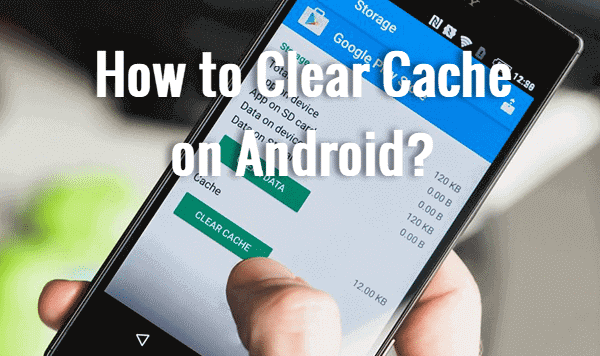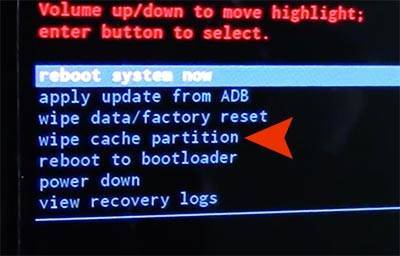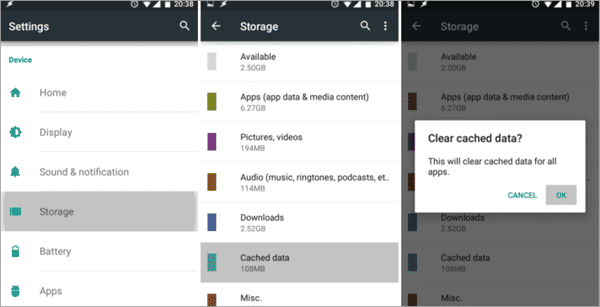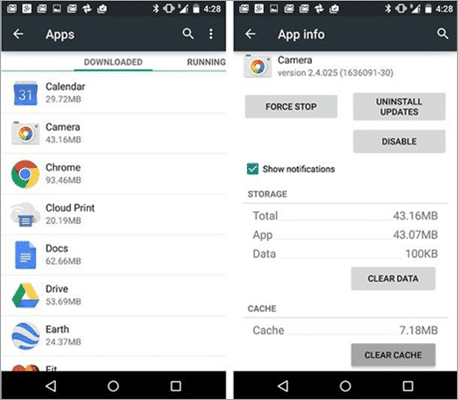What Is Cached Data And How To Clear Cache on Android
With the increased technological advancements, day after day we come across new terms that we really don’t know what they mean. If you are a smartphone user or a PC user, you must have interacted with the phrase “Cached Files”. Maybe a support team of a website you were trying to visit advised you to clear them after numerous failed attempts to access the site or an Android manual landed you there when trying to troubleshoot your Android phone.

Here is the truth; mobile phones were first introduced to ease communications through making calls and sending texts (You can schedule text messages on Android with these tricks). Today, they do more than that. We rely so much on our mobile phones for birthday or appointment notifications, surfing through the internet and using other apps that not only make our lives easy but also help us run our businesses smoothly. And the point is, every device that connects to the internet uses cached data in one way or the other.
PART 1. What is Cache?
Is cached data important? To easily make you understand the meaning of cache, we will use a practical example to define the cached data meaning. Imagine visiting a restaurant in town for the first time. Here is what your brain will do; It will register and store the route in your mind so that when you visit the restaurant again, it will be easier and quicker.
That’s the exact same thing that happens with cached data. When you use your Android smartphone browser to visit a website or an app, it stores some information (the route) in the form of cache in the device memory. The next time when you visit the same website or app using the same device, it is easier and quicker for the device to access it because your phone already has the route (cached data) stored when the website or the app was visited the first time.
PART 2. Why Do Cached Data Exist?
The primary reason why cached data exists is to reduce the loading time. Cached data files in Android devices exist for apps you regularly use and the websites you regularly visit using your smartphone. If the device already has the memory of the layout of the website or app stored in the form of cached data, it will not have to waste time loading the exact same data once again. This helps in increasing the process of loading the website or the app.
Cached data can be helpful for smartphones and computers but the problem is that they eat up the space on your device. Cached data on your device can be essential for the websites and apps you use regularly but a waste of space for those sites that you only visit just once. With time, it may get corrupt or even interfere with how you visit the same website on your device. And then you will begin to receive some of the common HTTP error codes like 500 when you try to visit a website.
PART 3. Why Should You Clear the System Cache?
System cache has all the data for all the apps you have used and all the websites you have visited on your device. There is also a chance that there still exists data of an app you may have uninstalled or a social media post or image that you already viewed and you are not opening again. It is therefore advised that you should clear the system cache every now and then so as to free up some space on your Android device or tablet. In this way, you will not be having trouble with your device system failing most of the time.
An Android device or tablet may have stored lots of data in the system cache and continuously need eve much more space. It is therefore unnecessary to give away essential storage space to system cache.
Is it OK to clear cached data, and what does it mean to clear the cache? Cache clearing is also an important routine in the troubleshooting processes to resolve a number of problems that may be a result of stacked and corrupted cached data, for example, the “Unfortunately, your app has stopped” error. It is important that you understand that all Android apps, whether they are system apps or third party apps will have cached data on your android device. And since cached data is automatically created and does not include any important data, taking some time to clear the cache for an app or the whole device is totally a safe thing to do. It will not harm your device.
We have been experiencing better updates on Android versions and for that matter, most of the time you may not need to handle system cache on your own. Android systems usually manage system cache very well. Android devices manage data from the apps very diligently. That is, as an Android user, you will not have to worry about handling cached data on your Android device manually. However, when your device begins to face issues and the manual asks you to clear cache while trying to follow some troubleshooting steps, I highly advise that you consider doing so.
Once cache has been cleared, you will notice a slight change in the speed at which the app or website will be loading a little slower for the first time. That’s because cached data will be created once again. Once the cached data has been recreated and stored, you will notice that accessing the website or the app the subsequent time is smoother and faster.
PART 4. How to Clear System Cache on Android Devices
As I had mentioned before, system cache is essentially files that are created when accessing Android systems. This data is associated with the system and the system files so as to ensure that your Android device works smoothly. While troubleshooting your Android device, there are steps that may require you to clear system cache of your Android device or tablet so that your device can create new system cache files.
You may wonder “How do I clear my phone’s cache”. Be at ease, the process of clearing system cache on Android devices is more similar across Kitkat, Lollipop, Marshmallow, Nougat, Oreo and above. The process begins with you entering your device’s recovery menu so as to clean the system’s cache section.
Here are the steps to clear cache on Android devices like Samsung Galaxy, HTC, Sony and etc.
How to clear system cache on Android 8.0 Oreo, Nougat, and Marshmallow
- Power off the Android device.
- Press and hold the “Volume Down” button and the “Power” key at the same time until the “Fastboot” menu appears on the screen (Fix Android Phone Stuck in Fastboot Mode).
- Now, release the “Power” key and use “Volume Down” key to highlight “Recovery”. Use “Power” key to confirm the selection.
- Immediately the Android bot icon appears on the screen, then press “Power” key and the “Volume Down” key together just once and it will take you to the “Recovery” menu.
- Use “Volume Down” key to highlight the option “Wipe cache partition” and press the “Power” key to confirm selection.

Once the system cache has been cleared, reboot your Android device and it will begin to create fresh new system cache.
How to clear system cache on Android Lollipop
The process of clearing system cache on Android Lollipop starts with switching off the Android device. After that, follow the steps below:
- Press and hold the “Volume Down” button and the “Power” key until the screen with some options appears.
- Now, release the “Power” key and use “Volume Down” key to highlight “Recovery”. Use the “Power” key to select it to allow your phone to boot into recovery.
- When a black screen appears, press and hold the “Volume Down” key until the “Recovery menu” appears.
- Use “Volume Down” key to highlight the option “Wipe cache partition” and press the “Power” key to confirm selection.
- Once the cache is wiped out, use “Volume Down” key to highlight the option “Reboot System Now” and select it using the “Power” key.
You will have an Android Lollipop device with new system cache files once the reboot is complete.
How to clear system cache on Android Kitkat
To clear the system cache in Android Kitkat, you also need to switch off the Android Kitkat device. Once it has been switched off, follow the steps below:
- Press and hold the “Volume Down” key.
- Press the “Power” button and release it while still holding the “Volume Down” key.
- Continue pressing the “Volume Down” key until three android icons appear on the screen.
- Select the “Recovery” using the “Volume Down” key and use “Power” button to confirm the selection.
- Once a red triangle icon appears, simultaneously press the “Volume Up” key and the “Power” key.
- Use the “Volume Down” key to select “Wipe Cache Partition” and then press the “Power” key to confirm the selection. After that, the phone will start to wipe the cache partition of your Android device. This may take some time.
- Once the cache partition has been wiped out, use the Power key to select the option “Reboot System Now”. Then Android device will restart and build new cache files as you start using the apps and visiting the websites all over again.
PART 5. How to Clear All App Cache on Android
There is a chance that you may be having unnecessary cached data stored on your Android device if you have never cleared cached data on your device before. They may be as a result of the apps you no longer use or you had uninstalled and deleted. These unnecessary cached data may get corrupted and start to cause problems on your phone. And that explains why many troubleshooting processes require you to clear cached data for all apps.
Here are the steps to clear cache for all the Android apps at once:
- Navigate to the “Settings menu” on your Android device.
- Look for “Storage” and tap on it.
- Tap on the “Cached Data”
- A pop up screen will appear to ask for a confirmation
- Tap on “OK” to completely delete all app cached data from the system.

After clearing cached data, you will notice that your apps will be taking a little longer to open. This is because they will be taking some time to recreate the cache files. The apps will open faster when you try to use them the second time.
PART 6. How to Clear App Cache for Individual Apps Only
- Go to the Settings menu, look for the Apps option and then tap on it.
- A list of all the apps on your devices will be presented to you. Tap on the one whose cache you wish to clear.
- Tap on Clear Cache to clear the cache data for that particular app.

Conclusion:
Will clearing cache delete pictures or other important files on Android? Well, it is important to note that clearing system cache or app cache will not erase the important information off your phone or the app. It is just a process to ensure that unnecessary cached data is eliminated to avoid trouble with corrupt cached data files. Besides, cached files for the app will be automatically be created the next time you launch the app.
If you find your important Android data lost due to some reasons, you may need this Android Phone Recovery tool to recover the deleted files from Android phone memory directly. All the lost contacts, messages, photos, videos, audios and WhatsApp can be retrieved via this powerful data recovery tool for Android.

